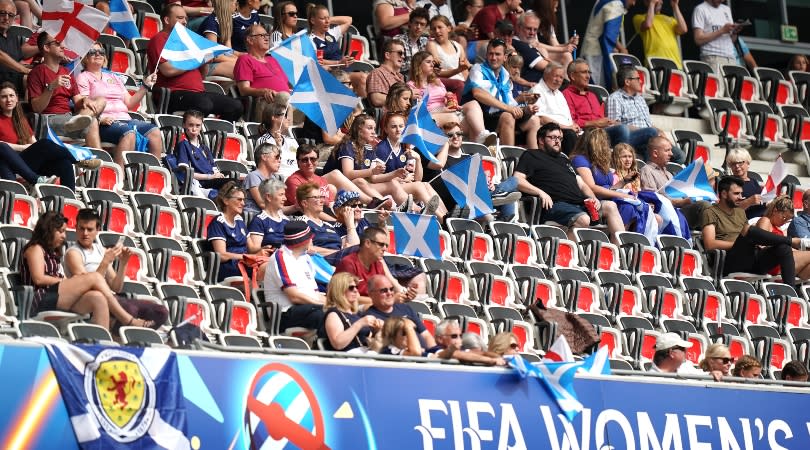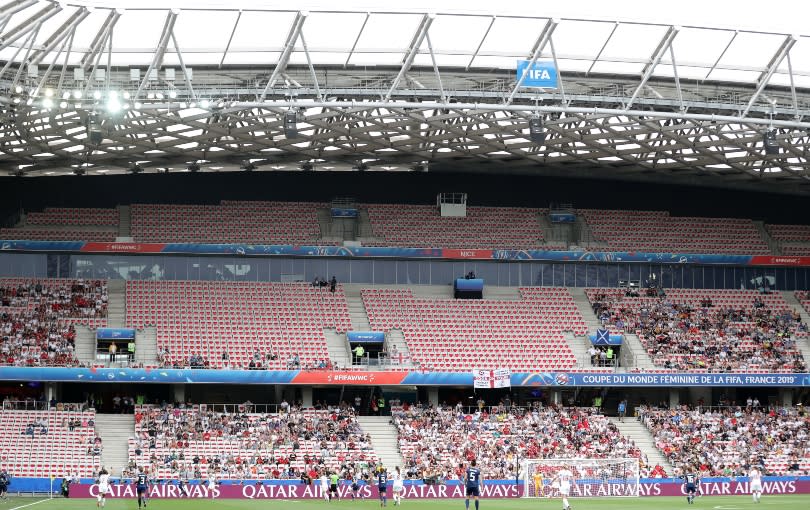We were promised sell-outs for the Women’s World Cup – so why the empty seats?
Following a season of domestic showpieces across Europe, including a record crowd of 60,739 watching Atletico Madrid vs Barcelona at the Wanda Metropolitano in March, there were hopes of attendance records continuing to tumble this summer.
This Women’s World Cup was trumpeted as the best and biggest to date, and communication from FIFA declared multiple matches as sell-outs (which they have since revised). Such hopes seemed justified.
But then, just weeks before the tournament kicked off in Paris, many fans who'd been quick to purchase tickets when they were first released in October 2018 discovered (though not through formal communication) that they may have to sit separately from those in their group. In some cases, parents were being separated from their children.
The initial response from FIFA was typically disappointing; an ‘I told you so’ tweet shirking all responsibility. Though they did eventually backtrack, recalling and reissuing tickets to those affected, such a blunder could hardly have helped to convince those yet to purchase tickets to commit their attendance.
Dear fans. We have noted some of your comments, re: your tickets. When you placed your order, a message indicating not all seats would be located next to each other did appear, before confirmation of your purchase. Unfortunately we will not be able to modify your order.
1/2— FIFA Women's World Cup (@FIFAWWC) May 20, 2019
The world governing body should be making it as easy as possible for fans to attend matches – it is, after all, in everyone’s interest. But as usual, it feels like fans are the last to be considered by the likes of FIFA and UEFA.
Fast-forward to the summer, though, and the opening Women’s World Cup match at Parc des Princes: 45,261 packed the stadium to watch France beat South Korea 4-0. Not a bad start.
But in the group matches that followed, the average attendance was just 18,498. Location and teams involved certainly impacted numbers: both France and the USA played in Paris, with the highest attendance so far being the 45,594 who saw the USA beat Chile.
In the south of France, it has been a different story. Just over 8,000 saw Cameroon beat New Zealand 2-1 in Montpellier – the lowest attendance so far – and the average turn-out at matches in Nice, excluding France vs Norway, was 12,273.
Walk around the Mediterranean beauty spot and you'd be forgiven for not noticing that there was major tournament being hosted there – something even England head coach Phil Neville picked up on.
"I've got the say the World Cup is more visible in the north than it is in the south," he noted. "We've been in Nice 15 days [in total] and at periods, in certain areas, you wouldn't know there's a World Cup going on.”
A modest crowd of 13,188 saw his Lionesses side beat Scotland 2-1 at the 35,000-capacity Allianz Riviera. It felt rather empty.
It isn’t until you reach the far end of Promenade des Anglais where the rather disappointing ‘fan park’ is located that any form of signage starts. Before England vs Scotland, it had just one stall for food and drink, and a 60-second walk around the square would show you everything there was to offer. As is standard with most fan parks, entrance was limited to ticket holders too. Given the obvious availability of tickets, though, it felt like a missed opportunity to drum up more sales. Intrigued passers-by weren’t able to enter and there were no provisions for on-the-day purchases.
There were also mixed reviews on the shuttle bus service provided to and from the stadium. A lack of communication around end destinations of the buses after matches saw some fans dropped off in car parks miles from the centre of Nice, with their only option to shell out for an £80 taxi.
Progress in terms of television coverage has been widespread, though. Over 200 broadcasters from all over the world are in attendance, demonstrating their commitment to showcasing the tournament.
According to BBC Sport – who are showing every match across their various channels and the red button – viewing figures peaked at 6.9m for England’s 3-0 win over Cameroon on Sunday, 40.5% of the available audience. That beat the previous record of 6.1m set just two weeks before for the Scotland match.
In Brazil, Rede Globo acquired rights to air the Seleção’s Women’s World Cup matches, meaning they were available for free for the first time. 19.7m watched their opener against Jamaica and a peak audience of 26.99m tuned in for the Italy match – the largest domestic audience of any group stage game this summer.
Increased visibility across television networks is undoubtedly a step in the right direction, with new audiences being introduced to the women’s game all the time.
The interest is there and building – that is no longer a debate. Converting that into regular attendance is the next challenge for governing bodies and leagues – and a good starting point may be a fan-first strategy. For once?
While you're here, why not take advantage of our brilliant subscribers' offer? Get 5 issues of the world's greatest football magazine for £5 – the game's greatest stories and finest journalism direct to your door for less than a pint in London. Cheers!
NOW READ…
TRANSFERS 5 centre-backs Arsenal could realistically sign this summer
QUIZ! Can you name the 44 teams Frank Lampard played against in the Premier League?

 Yahoo Sports
Yahoo Sports 


